The Sykes Brothers
Friend Sykes: b. 13 Nov 1887 – The entrepreneur
Harry Sykes: – The functionary
Eric Sykes: b. 18 Sep 1899 d. 1991 – Front man and manager
The brothers were from Ravensthorpe (Dewsbury) West Yorkshire, where their father was a coal merchant. He prospered and the family moved from a mean address, when Friend was born, to Grove House, Ravensthorpe when Eric was born 12 years later.
The brothers had a number of property interests prior to the acquisition of the Richings estate and were business associates of Mr W.H. Shaw (of Norman Shaw, accountants, Dewsbury) who became a director of the Richings Park Co. of 1926.
Of the three brothers, Friend the eldest was the entrepreneur and go-getter and seems to have developed a talent for PR. Prior to moving into the property development business he had been working for the then equivalent of the Ministry of Supply set up during the 1st world war.
In this role he toured the country buying standing timber for the government for pit props used in coal mining to replace the vast quantities imported from Sweden but prevented by enemy naval action in WW1.
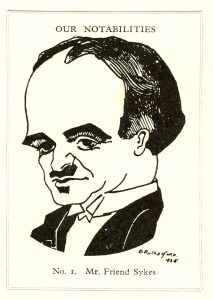
This had enabled him to establish a wide range of connections which were later to prove useful including The Tollemache Estate near Tarperley in Cheshire; Herbert Lushington Storey at Malmesbury in Wiltshire, Lord D’Arbenon’s Estate at Esher Place in Surrey and The Meeking Estate at Richings.
Friend initially wanted an estate near London, with farms which could produce food to sustain the board-lodging for the live-in shop assistants of the Wallis Department Store in Oxford Street in which he had an interest.
At that time a number of female employees “lived over the shop” even though it was a department store. After the war the changing world meant that the economics of estates such as Richings were no longer viable. Friend had the acumen to see this and to see how he could use it to his advantage.
Exploitation, pure and simple, however, was not his objective. Having acquired an estate of 4 farms he initially only developed only part of it: mainly the gravel uplift in the north east section, bounded by the 30m (100ft) contour line, which formed the southern part of the medieval Ridgeway field, lying south of the railway line. This was to be a spacious development, with only some 350 plots in the lay-out for the original area.
The 18th Century park and mansion were retained, the mansion for their own use, and also 2 of the farms – Old Slade and Home. These farms were retained as going concerns by the Sykes until 1931. Larbourne farm was sold off to the tenant Mr White. Tan House Farm, in Colnbrook, was also sold to the tenant, Mr Frank Purser.
When the Sykes Brothers bought the Estate at Richings their whole approach, their appointment of their chosen architect (and his approach) demonstrated an attitude which was and still is totally unlike that of most suburban developers. They retained their architect’s designs as their property. Hence those designs were not duplicated elsewhere.
All three brothers made the Estate their home and its name became the name of the “parent” company for other, later ventures. Certainly, Friend thought of himself, living in Riching’s Lodge, as the Squire of Richings.
In 1985 Eric Sykes, the survivor then aged 86, revisited Richings Park .
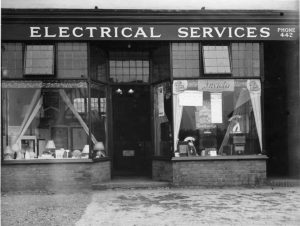
After all the years, he was re-seeing Richings Park for the first time as a mature neighbourhood graced with trees and gardens. It made him proud, he said, to think that “I created all this”.
The Sykes companies
Instrumental in all the dealings of the Sykes companies was their lawyer Mr Donald Whitby Roberts. In 1928 he was newly qualified and working for a law firm in Lancaster. The involvement of this firm with the newly set up Richings Park Company resulted in Mr Roberts being transferred from Lancaster to a new office opened by the law firm in London.
His first task was to represent the Richings Park Ltd, Company in a case in the Crown Court in Uxbridge and he was subsequently often involved in legal work for the company. He was a resident (8 Bathurst Walk) from 1931 until his death in June 2000.
Latterly he set up his own solicitor’s practice which was located in Richings Park and he acted for individual residents with the Official Receivers.
Phormium Company.
The brothers had originally formed the Phormium Company (a name still to be found on original Richings Park covers to drain inspection chambers).
The relevance of this name, presumably taken from the New Zealand flax plant, to the Sykes is not known.
This company had carried out a smaller development in Burnage on the Stockport side of Manchester between the A34 and A6 prior to 1922 when the Sykes purchased Richings Park. In 1928 the company set up its own brickworks at Charfield, Gloucestershire (on the Bristol – Gloucester railway Line and B4058 by Wotten-under-edge).
It traded as Phormium Co. with Eric Sykes as general Manager.
Mr Roberts was called upon to negotiate the contract between the Phormium Company and the GWR for the aerial conveyor which crossed the tracks between the clay pit and the works.
The kiln was first fired in 1929 and produced Clare’s patent brick pots, although it is not certain that the “pots” used in building Richings Park were fired here as many of the houses were built before this.
After the crash of 1931, the same brickworks under new owners, Messrs G.H.Downing, had a further 30 years of active life and the Phormium Company Ltd finally ceased to be in 1961.
Richings Park Companies
The Sykes development in Richings Park was initially a private enterprise in their own names. The initial capital was raised by selling two of the estate farms to the existing tenants but In order to fund further development, Eric Sykes took out mortgages with Barclays Bank dated 29 Jan 1925 and 10 Jul 1926, having convinced the bank that a garden village based on the fashionable Letchworth model was a good investment, particularly one based on a rapid construction method which could keep the costs down and make the houses attractive to purchasers.
Certain plots were specifically excluded from these mortgages as they had already been sold and houses built or in the process of. These included those presently numbered 2, 4, 6, 8, 10, 12, 14 and 16 Somerset Way and 17, 19, 21, 23, 25, 6 and 8 Wellesley Avenue.
As the confidence of the Sykes brothers grew so too did their plans for the estate. They convinced the Great Western Railway that a new commuter station would be to their mutual advantage and this was duly opened on 1st December 1924.
Even if Richings Park had reached its intended size the station would have remained on the edge, as it is now. Timetables from the time indicate that the service was better then than now! Thereafter, the railway also promoted the Estate in its company magazine; it had already previously provided a bus service from West Drayton.
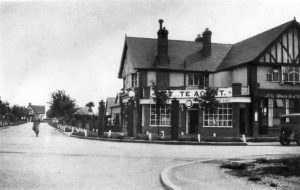
In 1926 a private company was created, the Richings Park Estate Company, with the Sykes retaining some parcels of land for themselves and conveying the rest (specifically excluding the plots already sold) to the company.
There is some information that this company failed, in any event a public company Richings Park (1928) Ltd. Property Company was proposed in 1928 and came into being in 1929. Information from Mr Roberts indicated that a liquidator wound down the private company and transferred its assets to the public company.
Herbert Lushington Storey (1853 – 1933) Deputy Lieutenant of Lancashire was persuaded by the egregious Friend Sykes to become the chairman of the Board of the 1928 company and a considerable investor. Mr Storey, of the famous Storeys of Lancaster, was a retired JP at that time living in Burton Hill House, Malmesbury, Wiltshire, where he raised horses.
He insisted that his law firm, lead by Capt. A.C.N. Dixey, Tory MP for Penrith and Cockermouth (1923-1935), should replace the firm from Dewsbury and Captain Dixey’s new London Office in Grosvenor Street W1 was set up.
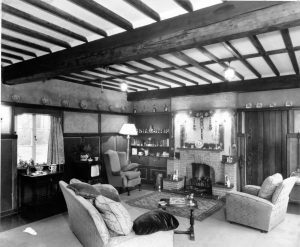
The launch of the public company in 1928 found them in prestigious offices at Walmer House, 298 Regent Street (between Oxford Street and Langham Place) from June 1928 until the company went into receivership in 1931. The registered company office was 49 East Cheapside Friend and Harry were Directors of the public Company but Eric was not.
He was the employed agent in whose name property was listed and dealings effected.
With the formation of the public company run by a board, a more commercial view was evident with significant more development over the parkland as set out in a formal Report and Valuation prepared by a City of London firm of surveyors. By this time Syke Cluan and Syke Ings had already been made up and adopted by the highway authority and Bathurst Walk was about to be adopted.
The 1928 plan for Richings Park was never completed. Main Drive and South Drive were to be fully developed (the development of Main Drive eventually occurred between 2000 and 2009) and the land of the two farms would be taken up with in-fill back from the Poynings and the Ridings stretching all the way to Colnbrook where there was to be another parade of shops. Four areas of tennis courts were included, but the ornamental lake in the park was was ignored as a feature.
The western end of Bathurst Walk should have continued parallel with Syke Cluan, eventually to join up with North Park, which accounts for the cul de sac of St James’s Walk which should have linked up with this. The proposed cinema was developed along with some of the planned shops. The hotel next to the cinema never saw the light of day.
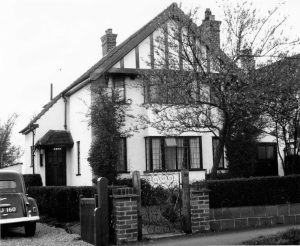
Although the Richings Park development managed quite well following the 1929 Wall Street crash, despite some defaulters, the investment in a property on Oxford Street which failed and other speculations (see below) may well have overstretched the company and when the bank reneged on a promise of a further loan, the company became insolvent.
In 1930 the board declared a loss of confidence in the Sykes. Friend and Harry had to resign from the board. (Eric was not on the board). The Debenture Shareholders, fearing for their dividends, approached the Judge in Chancery and secured the appointment of a receiver (Price Waterhouse).
His only recourse was to begin selling off assets to secure the Debenture interest, chief of whom was Lloyds Bank. Other creditors and shareholders received nothing. By 1931 the entire Sykes enterprise had ceased to exist.
The establishment of the Receivership was not an instrument of liquidation of the company which continued trading. Most of the company’s assets that could be realised were sold off, thus beginning the control by Boyer which continues today. In 1938 Boyer Sand and Gravel (which became part of Hall-RMC) purchased the Mansion and the remnants of the estate and park, including Home Farm and Old Slade Farm.
Mr John Leno of Farr-Bedford was the agent who arranged this and other transactions for the receiver. Post war, Boyer sold on plots for houses to the developers including Cotton (The Poynings) and subsequently to Warren (Bathurst Walk). Boyer also acquired control of Sutton Farm around this time. Mr George Robert Norrish, an ironmonger from an old Chiswick family, bought several plots of land along Bathurst Walk – from the receiver or Boyer?
The receivership lasted until well after 1945 and it seems that at some point in the 1950s Mr Roberts was informed by the Receiver that he had no further interest in the Richings Park Company. There was no formal liquidation and bankruptcy of the company or official termination at this time.
Searches at Companies House and the Public Records Office at Kew revealed that none of the companies were ever declared bankrupt. However, there appear to be no records for the Richings Park (1928) Ltd. Estate Company at all. The assumption is that at some point the company was wound up and its small amount of remaining land assets transferred to the Crown.
The records for the Phormium Co. Ltd were destroyed 1961 at the end of later ownership and the records of Outram Estates Ltd were also destroyed although no date could be found indicating that at some point this company was terminated.
Other Company Developments
The 1928 company prospectus included a proposal for another, more luxurious Estate at Esher Place (Surrey), bought from Lord D’Abernon. From the hill where Lord D’Abernon’s 19th Century mansion still stands, the site spread west to straddle the River Mole.
There was to be a swimming pool, tennis courts, a golf course and another new railway station – near today’s Hersham Station on the main line to the South West from Waterloo just east of Walton-on Thames Station. Sandown Race Course was next door and the 19th Century mansion was to be a Country Hotel and Golf Club.
Rowing was also proposed, with special housing earmarked for the rowers. But by the time of the failure of the company in 1931, only a few of the proposed houses had been built.
In 1999 around a dozen houses on Pelham Way and Esher Place Avenue remained which could be clearly identified as coming from the drawing board of George Clare; these houses were about one and a half times the size of Richings Park houses.
Other schemes came under another subsidiary – Outram Estates, which was concerned with buying property in and near Oxford Street, which was, at that time, in a fervent of property speculation. The principle scheme was referred to as “Reverentia” and was thought to be aided and abetted by Sir Howard Frank (Knight, Frank and Rutley).
The scheme was to build on Oxford Street a department store to outdo Selfridges (which had opened in 1909). Friend Sykes seemed to have overlooked the fact that Gordon Selfridge really was a close friend of Sir Howard Frank. “Reverentia” was the name of a race-horse owned by Friend Sykes.
As Mr Roberts dryly commented: “The horse didn’t win either”. The scheme had a backer in a Mr Price (a 50 shilling tailor), but come the 1929 Wall Street Crash and the slump thereafter in this country, he withdrew and the whole scheme failed. Interestingly, Outram Estates were quoted in the later conveyances of plots in The Poynings in 1931.